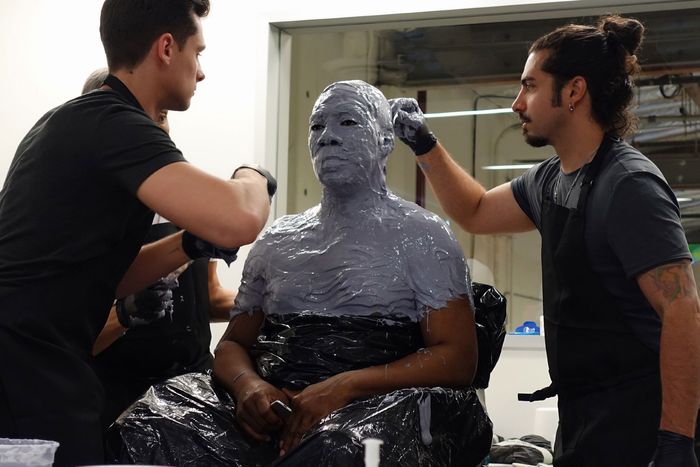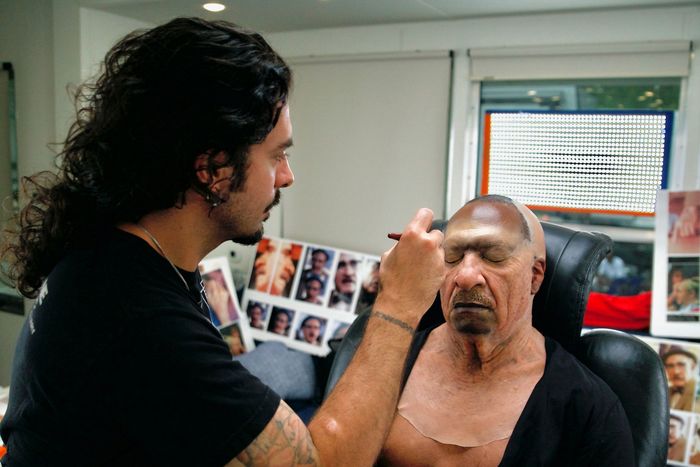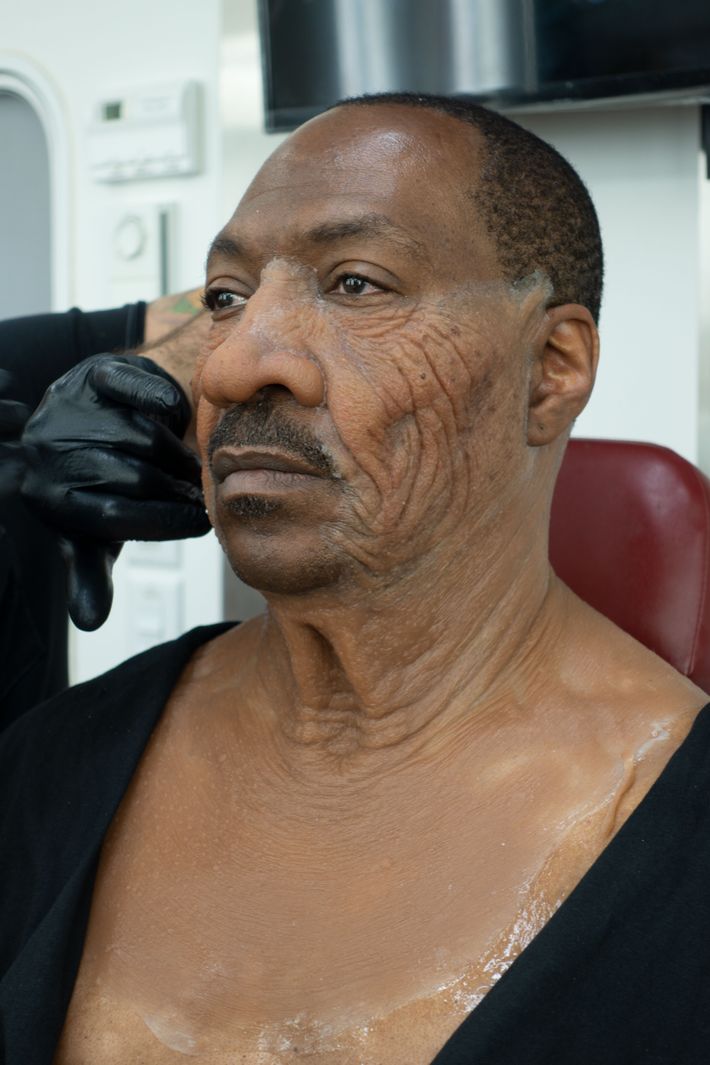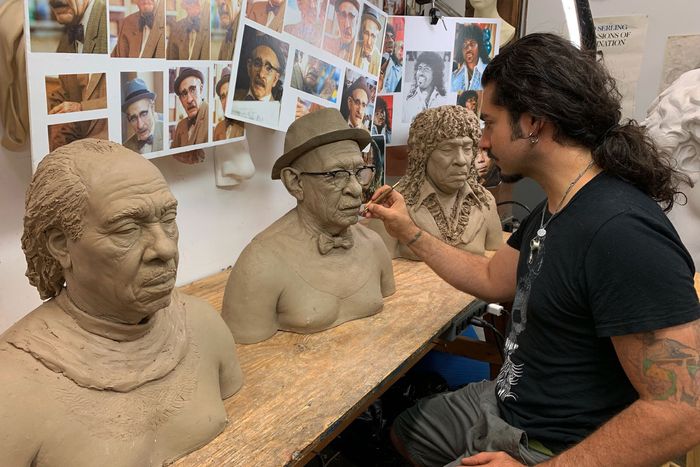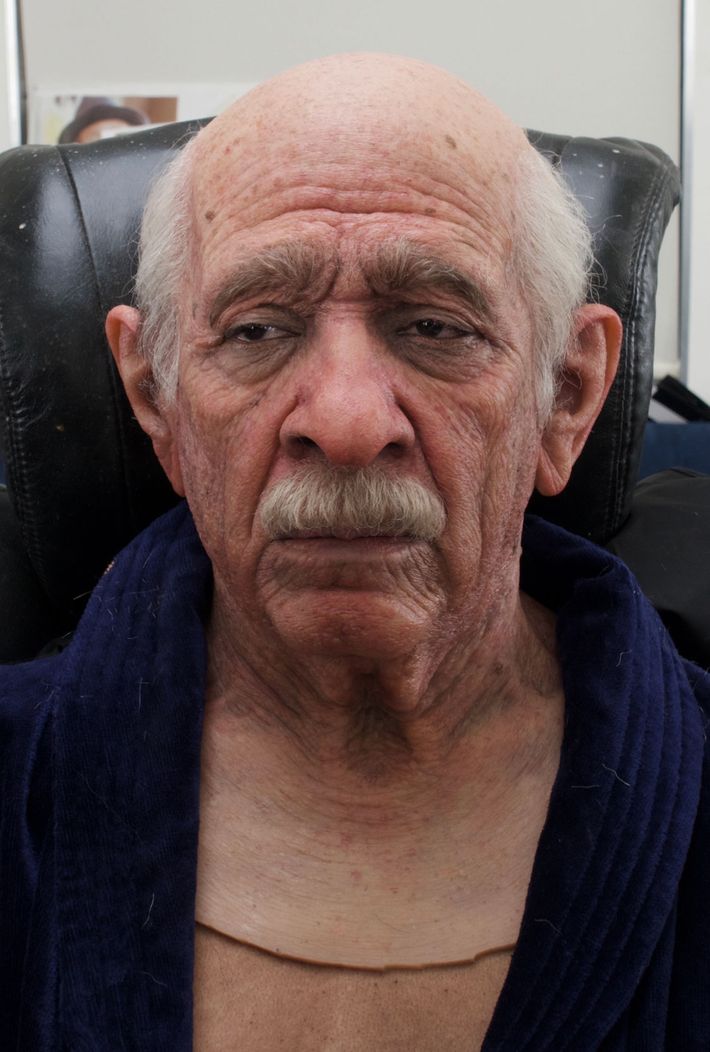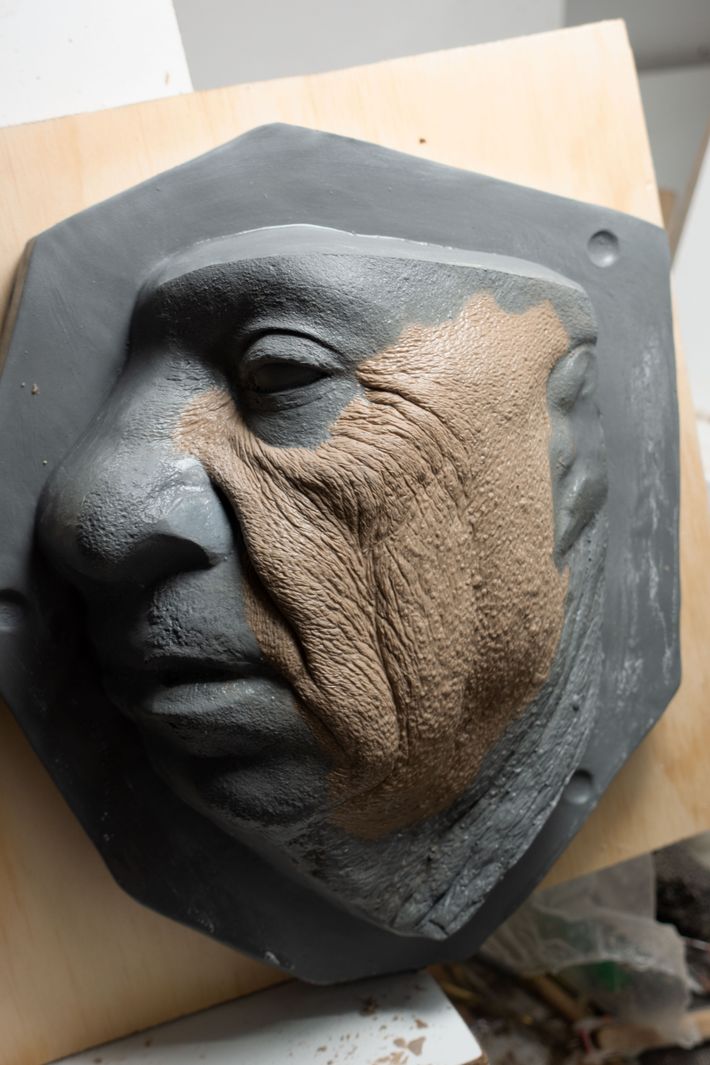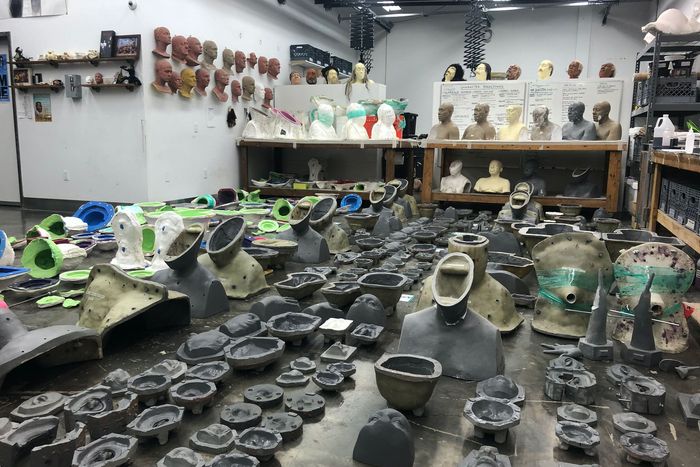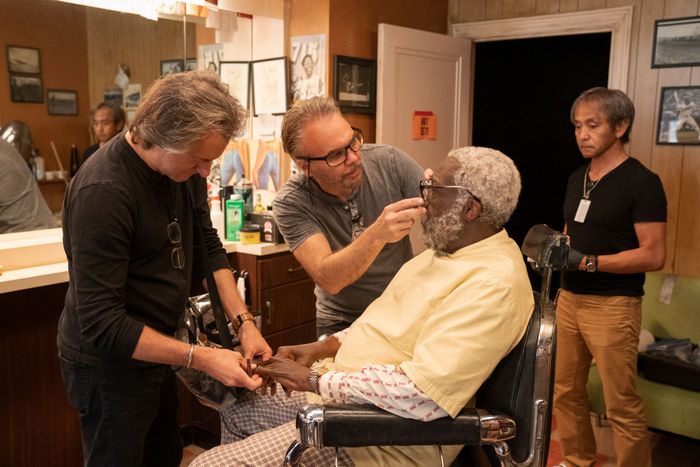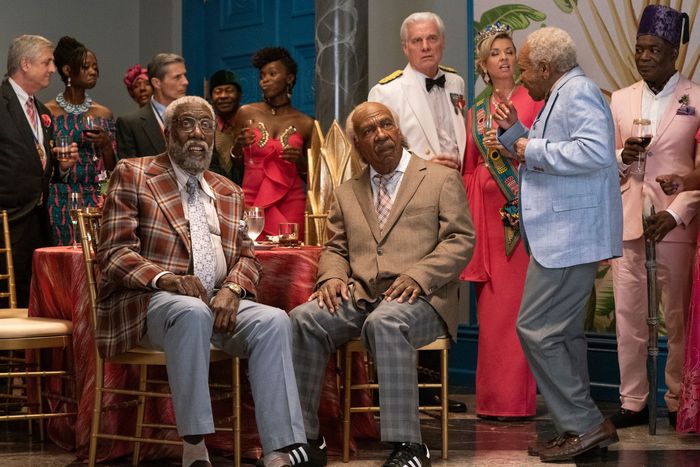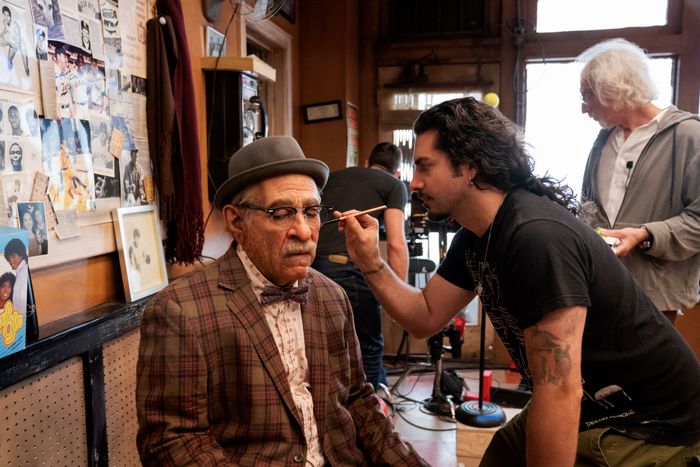
The funniest parts of Coming to America are easily the scenes in which Eddie Murphy and Arsenio Hall are transformed into the movie’s most unforgettable minor characters: Clarence, Saul, and Morris from the My-T-Sharp barbershop, the lecherous Reverend Watson, and Sexual Chocolate frontman Randy Watson. The same can be said for the sequel, where all of these characters return, a little bit older and, in Watson’s case, a bit worse for wear.
One person who didn’t come back for Coming 2 America is makeup artist Rick Baker, who created the prosthetics that allowed Murphy and Hall to disappear into these roles. This time, the job fell to Prosthetic Renaissance’s Michael Marino, who describes his job of character makeup designer as “the guy that tortures Eddie and Arsenio.” Over the course of ten to 12 weeks, he and his team painstakingly created updated looks for all of those characters, plus a new one, the witch doctor Baba, molding thousands of pieces of silicone to attach to the actors’ faces and hands, building dentures and wigs out of real hair, and coloring every age spot and pore. Vulture caught up with Marino to talk about the in-depth process of transforming Murphy and Hall, the hilarious hours they spent in the makeup room together, and the surprising inspiration he got from Rick James.
The First Steps
Before Marino could mold the dozens of pieces that each character required, he had to create “lifecasts” of Murphy and Hall to get the accurate dimensions of their bodies. “It’s a crazy process,” he says. “You basically mix up this rubber and they have to sit there for 20 minutes while you’re putting this rubber on them. Then you back it up with plaster bandage and create an exact replica of their heads, and scan their bodies in. Once we have all the information we technically need, we bring it to our studio and cast out copies in plastic. That’s a day.”
The next step was getting a general sense of how the characters should look now compared to Rick Baker’s 1988 designs. “We printed out every possible photograph of each character from the original film and pasted them all over my studio. We kept the original film on a huge screen in my studio all the time, took notes, all this research,” says Marino. “Rick had set up a very specific way that they look — the features, the wrinkle patterns, all that kind of stuff. I and my team took all of those setups, mimicked each line, and said, ‘Okay, well how would it age, if it actually aged?’ It was very difficult.”
Marino also put particular thought into how Randy Watson would look in the present day. “Originally, they said, ‘Maybe he should have gray hair.’ I said, ‘No, no, no, he can’t have gray hair. He kind of cares about himself, but he doesn’t, you know?’ Imagine being a singer that’s just constantly drunk or eating wedding food for 30 years — what do you look like? He’s vain, so maybe he thinks his hair is still good, so he dyes it and the mustache, but his body is terrible. He’s fat, kind of beat-up looking, and weathered. So, basically, I looked at pictures of Rick James just a couple years before he died. He really let himself go. I printed all those photos, called Eddie, and said, ‘I think it would be cool to do like an homage to Rick James,’ and he said, ‘I like that idea. I was friends with Rick James.’ So, I went with it. I mimicked Rick Baker’s original look, which is such good makeup that you almost can’t tell it’s Eddie. I mixed it with Rick James in his later years, made fat suits, the black mustache, goatee, and Jheri curl.”
The Build
Once the designs were settled, Marino and his team had to actually build out the pieces that would be affixed to the actors. The first step was designing the looks out of clay on the molds of Murphy and Hall’s bodies, then breaking them into smaller pieces that could be manufactured individually.
“The molds are made out of this aerospace plastic called syntactic epoxy, which is this crazy material that was invented by NASA or something,” he says. “It’s the best material as far as the accuracy of detail. The silicone pieces we fabricate out of those molds are platinum silicone. It’s basically like a breast implant but on your face.
In some cases, the semi-translucent silicone matched the actors’ natural skin tone, but in the case of Saul, the elderly white Jewish man, and Morris, “the darkest guy in the barbershop,” Marino had to make adjustments in the tinting. To make the pieces react naturally to their expressions, some of the pieces of silicone were as thin as half a millimeter. “It has to respond exactly to how the actor underneath responds. Every line, crease, and wrinkle really has to move,” Marino says. “It’s essentially like moving sculptures that are painted. It’s also like the worst plastic surgery a celebrity could ever have, making them look ugly or older. When I walk into the trailer, it’s mostly like, ‘Oh, God.’”
The Application
In the set’s makeup trailer, Marino spent plenty of time with Murphy and Hall, attaching the silicone pieces and wigs onto the stars using medical-grade adhesive. “We glue every little piece to their skin so there are no air bubbles and then airbrush every freckle, color, mole, and shade difference,” he says. “The most difficult makeup was Saul because not only are you disguising Eddie, you’re changing his color. That took about five hours, the fastest we could do it. And every character wears high-detailed dentures. After the makeup is ready to go and they get dressed, the teeth go in last. They fit perfectly and change the voices. As soon as the teeth go in, Eddie was talking just like Saul.”
Because it would be too time-consuming to switch between looks, Murphy and Hall would spend two to three days shooting all the scenes for each character. Then there was the makeup removal process. “Each day, the wig is delicately taken off, ventilated in a very fine lace net, and cleaned,” says Marino. “But the prosthetics are so soft that it’s impossible to keep them, so they’re thrown in the garbage. The next day, the pieces are prepared and put on new. It’s like sidewalk art — it rains and then the beautiful mural on the ground gets washed away.”
Luckily for Marino, Murphy and Hall’s professionalism made the hours in the trailer easy. “Eddie is like a Buddhist monk. He just sits there and watches something on TV. We laugh, we talk a little bit, but he sits perfectly still, and that’s that,” Marino says. “Arsenio’s different. He sits perfectly as well, but it’s like a full-on comedy show. It’s the greatest jokes, stand-up, all done in character. The Baba character, which was based on this crazy-looking character from the show Shaka Zulu, was originally going to be Dave Chappelle, but he couldn’t commit, so we made Arsenio into that character. It was great because he was practicing what he was gonna sound like with me while we were doing the Reverend makeup, that funny, older, freaky voice that he came up with. It was amazing. I wish that was recorded.”


